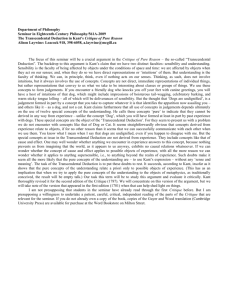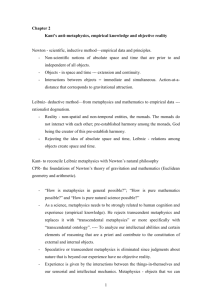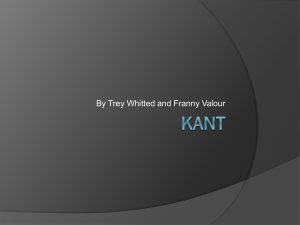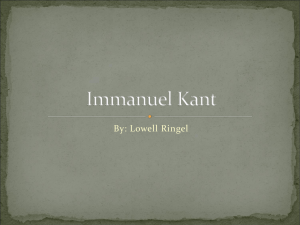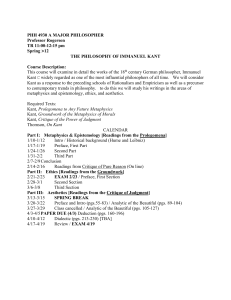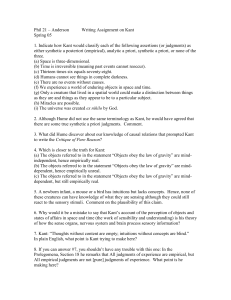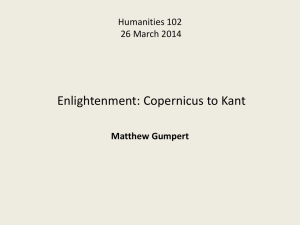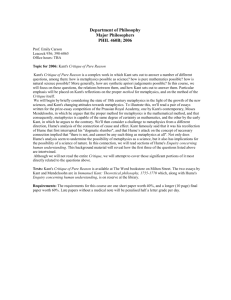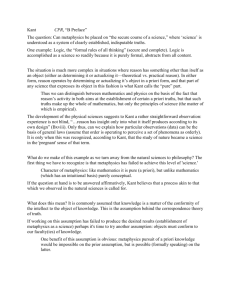Chapter 2
advertisement
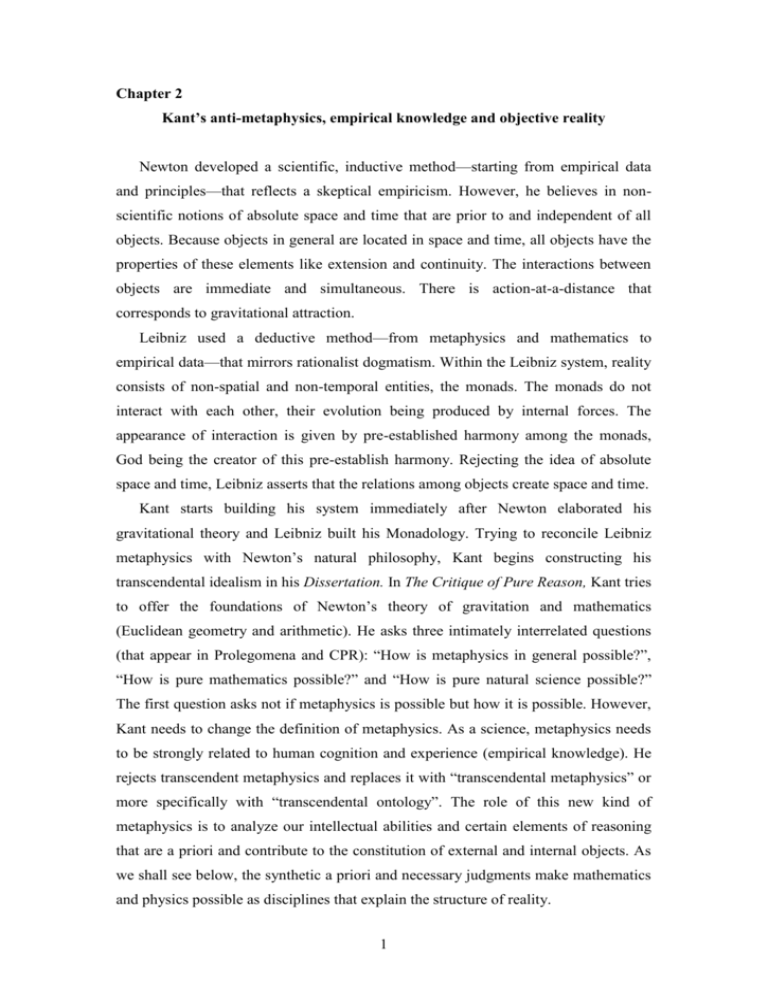
Chapter 2 Kant’s anti-metaphysics, empirical knowledge and objective reality Newton developed a scientific, inductive method—starting from empirical data and principles—that reflects a skeptical empiricism. However, he believes in nonscientific notions of absolute space and time that are prior to and independent of all objects. Because objects in general are located in space and time, all objects have the properties of these elements like extension and continuity. The interactions between objects are immediate and simultaneous. There is action-at-a-distance that corresponds to gravitational attraction. Leibniz used a deductive method—from metaphysics and mathematics to empirical data—that mirrors rationalist dogmatism. Within the Leibniz system, reality consists of non-spatial and non-temporal entities, the monads. The monads do not interact with each other, their evolution being produced by internal forces. The appearance of interaction is given by pre-established harmony among the monads, God being the creator of this pre-establish harmony. Rejecting the idea of absolute space and time, Leibniz asserts that the relations among objects create space and time. Kant starts building his system immediately after Newton elaborated his gravitational theory and Leibniz built his Monadology. Trying to reconcile Leibniz metaphysics with Newton’s natural philosophy, Kant begins constructing his transcendental idealism in his Dissertation. In The Critique of Pure Reason, Kant tries to offer the foundations of Newton’s theory of gravitation and mathematics (Euclidean geometry and arithmetic). He asks three intimately interrelated questions (that appear in Prolegomena and CPR): “How is metaphysics in general possible?”, “How is pure mathematics possible?” and “How is pure natural science possible?” The first question asks not if metaphysics is possible but how it is possible. However, Kant needs to change the definition of metaphysics. As a science, metaphysics needs to be strongly related to human cognition and experience (empirical knowledge). He rejects transcendent metaphysics and replaces it with “transcendental metaphysics” or more specifically with “transcendental ontology”. The role of this new kind of metaphysics is to analyze our intellectual abilities and certain elements of reasoning that are a priori and contribute to the constitution of external and internal objects. As we shall see below, the synthetic a priori and necessary judgments make mathematics and physics possible as disciplines that explain the structure of reality. 1 Speculative or transcendent metaphysics is eliminated since judgments about nature that is beyond our experience have no objective reality. Experience is given by the interactions between the things-in-themselves and our sensorial and intellectual mechanics. You can know an object only when you access it directly by experience. Thus, metaphysics has to deal only with objects that we can know; it is about the socalled metaphysics of experience.1 Kantian transcendental idealism is of course different from other approaches like Locke’s empiricism, Berkeley’s idealism and Descartes’ rationalism. However, Kant borrows certain elements from each important approach in constructing a new one. For explaining reality or empirical objects, Locke focuses on sensorial data, Berkeley emphasizes the content of mental states, and Descartes accentuates the role of ideas. In the pre-Kantian period, philosophers believed that we could acquire knowledge about the real nature or real external objects. Kant generates the Copernican revolution in philosophy. Changing the preCopernican perspective, he claims that objects (internal and external) conform to our modes of cognition in our process of knowing them. This means that the subject constitutes the objects. (See Friedman 1992; Parvu 2004) It does not mean that the external objects do not exist at all. While they exist, we cannot know them “as they are” but only “as they appear to us” and this is because of the conditions of experience that are a priori in relation to the objects. The notion of “conditions of experience” is equivalent to that of “transcendental”. (Parvu 2004, 51) Any knowledge presupposes certain conditions of experience. Thus, what we can know are phenomena but not noumena or things-in-themselves. The limits of our knowledge are identical to the limits of our experience: “what can be known is what can be experienced, and what cannot be experienced cannot be known.” (Gardner 1999, p. 24) Thus, the traditional distinction between ontology and epistemology is blurred. (Gardner 1999, p. 39) In order to avoid Humean scepticism, Kant offers serious arguments for the objective reality2 of our knowledge. The phenomena, as constituted by the subject, have objective reality. The objects are objects of our experience, but the conditions of experience—pure intuitions of space and time and categories—offer us the objective The title of Paton’s book is Kant’s Metaphysics of Experience, in Allison (1983, p. 174) and Gardner mentions this expression in his introductory book on Kant. (Gardner 1999, p. 24) 2 The distinction between objective validity (that refers to the truth-value of judgments) and objective reality (that refers real objects) is well known. (Or Caimi’s distinction between “formal objects” and “real objects”. Caimi, p. 61 in Parvu 2004, p. 398) 1 2 reality of our knowledge. If we accept the noumena-phenomena distinction, then the conditions of our experience provide our knowledge with objective reality. This notion of objectivity takes for granted the human subjectivity given by our conditions of experience. Following Descartes on this point, Kant reduces ontology to epistemology. The world that we can perceive and with which we interact directly is our world and not the world-in-itself. The interaction between our pure forms of intuitions, categories and noumena produce phenomena or appearances. Due to the a priori intuitions (space and time) of sensibility and to the categories of understanding, human beings cannot access noumena (things-in-themselves). These forms structure the external or internal raw material. Evidently, “objects that conform to our mode of cognition are exclusively objects of sense experience.” (Gardner 1999, p. 44) Thus, the distinction between appearances and things-in-themselves corresponds to the distinction between the metaphysics of experience and transcendent metaphysics. Pure intuitions applied to things-in-themselves produce empirical intuitions. The subject interacts with the things-in-themselves. From their interaction, we have the appearances that involve the empirical synthesis in imagination that is possible due to the synthetic unity offered by pure forms of space and time. For us these are the appearances. The application of understanding to intuitions represents the transcendental apperception. (Friedman 1992) Pure intuitions and categories are applied to the external manifold creating the objects of experience, i.e., empirical objects. The philosophy that analyzes the conditions of experience is called “transcendental philosophy”. Before presenting the table of categories, Kant defines the essential notion of synthesis (A77/B103) which, when associated with other elements, appears under different definitions. Synthesis is similar to the definition of functional unity: it is the act of putting the manifold of something (intuitions or representations) together. Regarding the representation, to put together different representations in one representation means to grasp their manifold in one act of knowledge. As Brook writes, synthesis is a) the combination of different elements into a unified representation b) the combination of representations and their objects into one item of knowledge. 3 We have to preserve this idea that synthesis unifies the manifold of intuitions and representations; this is the first process that gives rise to knowledge. Then to what do these representations refer? They can refer to different individual objects that have to be synthesized in “one experience”; moreover, all these representations of “one experience” belong to the single common subject. Thus everything must be synthesized! “We must synthesize if we are to recognize anything as synthesized (even space and time)” (Letter of July 1, 1797, Ak. XI: 514 in Brook 1994, p. 122) Synthesis is a transcendental process that belongs to the subject. If knowledge has two aspects, the forms and the content, then synthesis (i.e., the process of unifying the manifold) creates the content to which the forms are applied. Kantian distinction between pure and empirical is applied to synthesis, too: it is pure when the manifold is given a priori. When the manifold is given empirically, we have empirical synthesis. 2.1 Transcendental deduction We have to consider two things for understanding the transcendental deduction: a) In general, each notion has two meanings, pure and empirical. b) The main point for Kant is to determine the conditions of possible experience. Again, these distinctions are transcendental ones. As I noticed above, it is without sense to check for empirical elements corresponding to these notions. We then assert that the conditions of the possibility of experience in general are likewise conditions of the possibility of the objects of experience, and that for this reason they have objective validity in a synthetic a priori judgment. (Kant A157/B197 in Parvu 2004, pp. 17, 153, 407, 410) Kant’s theory is beyond the eternal debates between empiricism and rationalism because in his theory both elements are strongly related: the conditions of possibility (abstract-theoretical) and the experience (empirical). Pushing further Heidegger’s interpretation of CPR, Parvu reconstructs one of Kant’s main ideas, that is, searching for the conditions of possibility, the theoretical structure of the CRP’s frame-theory is ontologically loaded. The possibility of experience becomes actual, real in interaction with noumena. Kant’s theory establishes the structure of experience, it constitutes “the form of any possible knowledge” (Pippin 1982, p. 13 in Parvu 2004, p. 264) In the first edition, the general framework of deduction contains three notions: intuition that belongs to sensibility (the notion is analyzed in the Aesthetic), 4 imagination, and categories that belong to apperception. Applying Kantian distinction between pure and empirical we have: pure and empirical intuitions (as we saw above), pure and empirical imagination, and pure and empirical apperceptions. All these elements are interrelated or overlapping with (pure and empirical) consciousness and (pure and empirical) understanding. At (A95), Kant prepares the framework for these three elements, “the original sources” or “the conditions of the possibility of all experience”, sense, imagination and apperception. Each element corresponds to a particular process: the synopsis of the manifold a priori through sense; the synthesis of this manifold through imagination; and the unity of this synthesis through the a priori apperception (A115). In the second edition the main notion is “the original synthetic unity of apperception” (the OSUA) related to self-consciousness. Applying Kantian distinction between pure and empirical to the apperception we have: a) OSUA or pure (transcendental) apperception, or the transcendental condition of experience. More important for me is that transcendental apperception is related to the “recognition of the identity of the ‘I think’ that accompanies diverse representations”. (Allison 1983, 274) b) Empirical apperception or ordinary introspection (Allison 1983, p. 274) or the problematic identification with inner sense (see Allison, p. 273). The OSUA is one of our a priori faculties that belong to understanding and not to sensibility. It is an act of spontaneity and not an act of receptivity (B132). What does Kant more exactly mean by OSUA? Each normal human being is always in contact with the surrounding environment and this relationship generates certain representations in our mind. In normal conditions (when we are not sleeping, etc.), we are aware of some of these representations. In this case, it means that it has to be possible for the representation “I think” to accompany all my representations (B132). “I think” accompanies with certainty those representations—for example, the representation Y—that I am conscious or aware at one moment. All the representations are “my” representations because they belong to my selfconsciousness and it is possible for “I think” to accompany them. In fact, the unity of apperception presupposes the unity of the self. Thinking requires this unity. Without this unity, we would not be able even to think. In consequence, the OSUA includes 5 the process of unification of all my representations in one consciousness, my consciousness and the aptitude that represents the possibility of “I think” to accompany all “my” representations. In this case, synthesis is the process of unifying the manifold of representations. For Kant, one of the main epistemological questions is “How do we know an external object”? It is essential to specify again that such experience implies only empirical knowledge. The knowledge of an object requires pure intuitions and OSUA with its categories (and/or the unity of consciousness). These are the principles of our knowledge, i.e., the conditions of our experience. Even the mathematical concepts are knowledge only if we consider them as objects that conform to pure intuitions (B147). Taking into account that experience means empirical knowledge, the relationship between intuition and concept, i.e. the interdependence between sensibility and understanding, is essential. Here is one of the most quoted paragraphs from Kant’s Critique of Pure Reason: Without sensibility no object would be given to us, without understanding no object would be thought. Thoughts without content are empty, intuitions without concepts are blind. It is, therefore, just necessary to make our concepts sensible, that is, to add the object to them in intuition, as to make our intuitions intelligible, that is, to bring them under concepts. (A 51/B75)3 We can conclude here that the objective reality—that presupposes the unity of selfconsciousness, the categories, and the application of categories to the manifold offered by intuitions—is available only for empirical knowledge (experience). 2.2 The role of original synthetic unity of apperception for internal and external objects Empirical knowledge of external objects involves certain elements: pure intuitions and OSUA (that presupposes the categories), the external material (the manifold operated by intuitions and categories), the empirical intuitions and synthesis of apprehension, i.e., the applications of the pure elements to the noumena. Again this 3 In CPR there are numerous paragraphs in which Kant directly expreses the same idea of the application of categories to intuitions. (A few examples are A51, B75; B147; section 22 and 24; A239/B298; A240/B299; A241/B300; B306; A254/B309; A258/B314; B407) 6 distinction is a transcendental one. However, objective reality is guaranteed by synthesis of apperception through the categories. Kant has to answer one question that would immediately arise: where do the processes generated by OSUA take place? Evidently they occur within one subject. Thus Kant moves forward and establishes a kind of transcendental correspondence between OSUA and synthetic unity of self-consciousness. The last notion represents the “condition under which every intuition must stand in order to become an object for me”. (B138) The above correspondence is given by the synthesis because this process unifies, at different levels, the manifold of intuition in one and the same consciousness of a subject. With this idea, we return to the relationship between OSUA, self-consciousness and all “my” representations. Now all unification of representations demands unity of consciousness in the synthesis of them. Consequently it is the unity of consciousness that alone constitutes the relation of representations to an object, and therefore their objective validity and the fact that they are modes of knowledge. (B137) In fact, the unity of self-consciousness “is a necessary condition for the representation of an object.” (Allison 1983, 146) At the same time, apperception needs the representation of objects. Thus, there is bidirectionality between these two terms (or what Allison calls the “reciprocity thesis”). (Allison 1983, p. 144) 2.3 The schematism Because the categories and the intuitions are completely different notions, in order to unify them, it is necessary for there to be a third element that has to be homogeneous with both. The schematism unifies sensibility with understanding because the “sensible conditions under which alone pure concepts of the understanding can be employed.” (A136/B175) Transcendental cognition deals with our mode of cognition of objects—that has to be a priori—and not with the objects. As we saw above, this means that intuitions are applied to the objects of experience. I think that it is not the knowledge of those objects that is a priori but the intuitions, the categories and the possibility of their applications to the objects of experience. The antecedent element to the application is the possibility offered by a priori knowledge (intuitions and concepts) to empirical knowledge. The relation between pure intuition and objects is given by 7 the empirical intuition. Pure intuition and concepts lead to schemata and transcendental apperception, while empirical intuition and objects lead to particular images. Schemata are used for the proof of the universality of geometry. (Friedman 1992, p. 89) The categories are the conditions of possibility of (objects of) experience or they are “the formal conditions of scientific experience”. (Cohen 1885, 410 in Parvu 2004, p. 336) They are the functional foundation of experience, or in other words, the foundation of “immanent ontology”. Brook strongly emphasizes the role of the subject in the Kantian system in all the processes of the mind, i.e. its role in explaining the mind in general. It has no sense to try to explain how the representations are computed in the mind without taking into account the subject to which the mind belongs, with its computations and representations. Against Hume, Kant claims that the “associations of representations” is the empirical unity of consciousness. (Brook 1994, p. 91) However, Kant emphasizes the role of transcendental unity of consciousness, i.e., the transcendental apperception. The apperception of self, that is the common subject for all the representations, has nothing empirical. As we can see in A108, only the transcendental unity of apperception, i.e. the unity of the subject, offers the synthesis of all possible appearances in one experience or one nature. In Kant’s words: The original and necessary consciousness of identity on the side of the self is thus at the same time a consciousness of an equally necessary unity of the synthesis of appearances according to the concepts, that is, according to rules. (A108 in Brook 1993, p. 146) 2.4 Apperception and existence The unity of apperception implies the unity of nature. The expression “The ontology is immanent thinking” means that the experience of empirical objects is possible only if any such object can be thought a priori as a measure and similar to all the other categories. (Kant in a letter to J. Beck (20.01.1792), Parvu, p. 247) Thus, the form of intellect in relation with space and time constructs the “transcendental invariant” of objectivity in Kant’s theory. It is the foundation of ontology as “immanent thinking”. 8 (Parvu, p. 261) However, the analogies reflect the unity of nature, all phenomena (the determination of objects and the processes) must lie in one nature. For Waxman, the role of understanding in representing the world for Kant is this one: Thus do the categories become effectively the template of the sensible universe. More strikingly still: the understanding, in implementing this Bauplan by means of imagination, and thereby extending the scope of consciousness (that is, of that which is something for me), is actually doing nothing more than furnishing the I-concept with an expanded instantiation. The outcome of Kant’s theory of understanding could therefore be expressed as follows: the world is not simply my world, as with other subjective idealist philosophers; the world, for Kant, actually is the self. (Waxman, 1995, p. 857) 2.6 Against Kant’s perspective In this section, I will only sketch some lines of attacking Kant’s philosophy. It has been shown that Kant’s perspective is wrong from a theoretical point of view (by the mathematical construction of the non-Euclidian geometries) and empirically (through Einstein’s general theory of relativity). Non-Euclidian geometries and Einstein’s physics do not involve human perception. After polyadic logic and non-Euclidian geometries appeared, the perception and cognition of human thinking used in geometry and physics have been separated. In fact, the human perceptual field is not Euclidian space. If a human being observes two parallel lines that are long enough that person perceives those two lines in two different ways: a) when the two lines are close to the observer, they are parallel lines, but b) if the distance from the observer increase enough the lines become progressively closer and closer unifying at the horizon. Einstein’s theory was proved by the fact that solar light follows the curved space that exists near planets, i.e., they are geodesic lines. Friedman mentioned Hopkins who invokes “visual” or “phenomenal” geometry to explain Kant’s preference for Euclid. (Friedman 1992, p. 103) Against Kantian pure intuition of space, he asks how, through pure intuition, is it possible to distinguish between the sum of the angels of two triangles, one being 180º and the other being 180.000001º? Thus, in the post-Kantian period we have completely rejected both a) the necessity and the universality of certain principles (basic principles of geometry and mechanics) and b) the necessary relationship between the intuitions and concepts that are applied in exact science and the their apriority. 9 Many philosophers, from Carnap to Friedman, have tried to save certain elements from Kant giving up on the necessity and universality of these principles. With Einstein’s theory, it becomes clear that, in physics, a scientific theory is true even if it does not directly involve any spatio-temporal framework. Moreover, within quantum mechanics the existence of micro-entities are proved, indirectly, through empirical results or through pure theoretical elements offered by mathematics. Thus, since Wittgenstein, philosophers have discussed linguistic frameworks or scientific theories and not physical entities or the real external world. For logical positivism, language is a pre-condition for any science. (Romanos 1983, p. 23) For instance, Carnap tries to save the distinction between analytic and synthetic judgments by introducing the concept of a “linguistic framework”—against the necessity and universality of principles in science. Moreover, along the same lines, Kuhn brings in the concept of a “paradigm”, while Goodman introduces “worldviews”, and so on. From another point of view, evolutionary epistemology (Lorenz, Popper, Campbell, Wuketits, etc.) contradicts the Kantian notion of the “thing-in-itself”. For instance, Lorenz considers that the evolution of our species has taken place in direct contact with external reality and thus that our cognitive abilities and our knowledge are generated by the interaction between the body and the environment. (Lorenz 1941) 10
